Study on the Restraint Effect of Isolation Pile on Surface Settlement Trough Induced by Shield Tunnelling
Abstract
1. Introduction
2. Restraint Mechanism of Isolation Pile
2.1. Pile-Soil-Tunnel Interaction Mechanism
2.2. Melan Solution
2.3. Analytical Solution
3. Case Study
4. FDM-DEM Coupling Model
4.1. FDM-DEM Coupling Technique
4.2. Numerical Model
5. Analysis and Verification
5.1. Results of Analytical Solution
5.2. Results of FDM-DEM Coupling
5.3. Comparison with Field Measured Ddata
6. Conclusions
- (1)
- The restraint mechanism of isolation piles on the surface settlement trough induced by shield tunnelling is analyzed based on pile-soil-tunnel interaction mechanism. The friction between pile and surrounding soil is the principal reason of restraint effect. Based on the Melan solution and Loganathan formula, the analytical solution is derived. The analytical solution could reflect the restraint effect of isolation pile on the surface settlement trough from the internal mechanism;
- (2)
- Taking the Changsha Metro Line 5 from East Laodong Road Station to Huaya Station, where shield tunnelling passes through Huaya International Hotel at a close distance as an engineering background. The FDM-DEM coupling technique is introduced to establish the numerical model. The coupling numerical model could simultaneously satisfy the engineering analysis scale and reflect the friction characteristics between isolation pile and soil particles;
- (3)
- The FDM-DEM coupling model can simulate the impact of different ground loss rates on surface settlement trough by deleting and activating preset circle walls. The affected zone above the tunnel top has a wider range and a more uniform variation after shield tunnelling without isolation pile, while the range of affected zone decreases under the influence of isolation pile. The existence of isolation pile blocks the continuous development of soil displacement;
- (4)
- Comparing with field measured data, the applicability and reliability of the analytical solution and the FDM-DEM coupling model proposed in this study are verified. The ultimate surface settlement trough induced by shield tunnelling presents an asymmetric distribution due to the restraint effect of isolation pile on surrounding soil. The maximum surface settlement with isolation piles is less than that without isolation piles. Meanwhile, when isolation piles are pre-installed on one side of the tunnel, surface settlement tends to develop more on the side without isolation piles.
Author Contributions
Funding
Institutional Review Board Statement
Informed Consent Statement
Data Availability Statement
Conflicts of Interest
References
- Huang, K.; Sun, Y.W.; Zhou, D.Q.; Li, Y.J.; Jiang, M.; Huang, X.Q. Influence of water-rich tunnel by shield tunneling on existing bridge pile foundation in layered soils. J. Cent. South Univ. 2021, 28, 2574–2588. [Google Scholar] [CrossRef]
- Ding, W.Q.; Gong, C.J.; Mosalam, K.M.; Soga, K. Development and application of the integrated sealant test apparatus for sealing gaskets in tunnel segmental joints. Tunn. Undergr. Space Technol. 2017, 63, 54–68. [Google Scholar] [CrossRef]
- Gong, C.J.; Ding, W.Q.; Mosalam, K.M.; Günay, S.; Soga, K. Comparison of the structural behavior of reinforced concrete and steel fiber reinforced concrete tunnel segmental joints. Tunn. Undergr. Space Technol. 2017, 68, 38–57. [Google Scholar] [CrossRef]
- Lei, M.F.; Zhu, B.B.; Gong, C.J.; Ding, W.Q.; Liu, L.H. Sealing performance of a precast tunnel gasketed joint under high hydrostatic pressures: Site investigation and detailed numerical modeling. Tunn. Undergr. Space Technol. 2021, 115, 104082. [Google Scholar] [CrossRef]
- Zhou, Z.; Zhang, J.J.; Gong, C.J. Automatic detection method of tunnel lining multi-defects via an enhanced You Only Look Once network. Comput. Aided Civ. Infrastruct. Eng. 2022, 37, 762–780. [Google Scholar] [CrossRef]
- Huang, K.; Sun, Y.W.; Yang, J.S.; Li, Y.J.; Jiang, M.; Huang, X.Q. Three-dimensional displacement characteristics of adjacent pile induced by shield tunneling under the influence of multiple factors. J. Cent. South Univ. 2022, 29. [Google Scholar] [CrossRef]
- Bai, Y.; Yang, Z.H.; Jiang, Z.W. Key protection techniques adopted and analysis of influence on adjacent buildings due to the Bund Tunnel construction. Tunn. Undergr. Space Technol. 2014, 41, 24–34. [Google Scholar] [CrossRef]
- Fu, J.Y.; Yang, J.S.; Zhu, S.T.; Shi, Y.F. Performance of jet-grouted partition walls in mitigating the effects of shield-tunnel construction on adjacent piled structures. J. Perform. Constr. Facil. 2017, 31, 04016096. [Google Scholar] [CrossRef]
- Huang, K.; Sun, Y.W.; He, J.; Huang, X.Q.; Jiang, M.; Li, Y.J. Comparative study on grouting protection schemes for shield tunneling to adjacent viaduct piles. Adv. Mater. Sci. Eng. 2021, 2021, 5546970. [Google Scholar] [CrossRef]
- Peck, R.B. Deep excavations and tunneling in soft ground. In Proceedings of the 7th International Conference on Soil Mechanics and Foundation Engineering, Mexico City, Mexico, 29 August 1969. [Google Scholar]
- Fantera, L.; Rampello, S.; Masini, L. A mitigation technique to reduce ground settlements induced by tunnelling using diaphragm walls. Procedia Eng. 2016, 158, 254–259. [Google Scholar] [CrossRef][Green Version]
- Ding, Z.; Wei, X.J.; Wei, G. Prediction methods on tunnel-excavation induced surface settlement around adjacent building. Geomech. Eng. 2017, 12, 185–195. [Google Scholar] [CrossRef]
- Huang, K.; Sun, Y.W.; Huang, X.Q.; Li, Y.J.; Jiang, M.; Liu, R.N. Effects of different construction sequences on ground surface settlement and displacement of single long pile due to twin paralleled shield tunneling. Adv. Civ. Eng. 2021, 2021, 5559233. [Google Scholar] [CrossRef]
- Rampello, S.; Fantera, L.; Masini, L. Efficiency of embedded barriers to mitigate tunnelling effects. Tunn. Undergr. Space Technol. 2019, 89, 109–124. [Google Scholar] [CrossRef]
- Masini, L.; Rampello, S. Predicted and observed behaviour of pre-installed barriers for the mitigation of tunnelling effects. Tunn. Undergr. Space Technol. 2021, 118, 104200. [Google Scholar] [CrossRef]
- Franza, A.; Losacco, N.; Ledesma, A.; Viggiani, G.M.B.; Jimenez, R. Protecting surface and buried structures from tunnelling using pile walls: A prediction model. Can. Geotech. J. 2021, 58, 1590–1602. [Google Scholar] [CrossRef]
- Sun, Y.W.; Huang, K.; Li, Y.J. Influence of existing bridge pile foundation on the deformation of surface settlement trough induced by shield tunneling. J. Transp. Sci. Eng. 2022, 38, 79–87. (In Chinese). [Google Scholar]
- Cao, L.Q.; Chen, X.S.; Shen, X.; Zhang, D.L.; Su, D.; Fang, H.C. Theoretical analysis of the barrier effect of embedded isolation piles on tunneling-induced vertical ground displacements. Comput. Geotech. 2022, 144, 104609. [Google Scholar] [CrossRef]
- Loganathan, N.; Poulos, H.G. Analytical prediction for tunneling-induced ground movements in clays. J. Geotech. Geoenviron. Eng. 1998, 124, 846–856. [Google Scholar] [CrossRef]
- Melan, E. Der Spannungszustand der durch eine Einzelkraft im Innern beanspruchten Halbscheibe. J. Appl. Math. Mech. 1932, 12, 343–346. (In German). [Google Scholar] [CrossRef]
- Poulos, H.G.; Davis, E.H. Elastic Solutions for Soil and Rock Mechanics, 1st ed.; John Wiley and Sons: Hoboken, NJ, USA, 1974; pp. 1–28. [Google Scholar]
- Verruijt, A.; Booker, J.R. Complex variable analysis of Mindlin’s tunnel problem. In Proceedings of the Developments in Theoretical Geomechanics, Sydney, Australia, 16–17 November 2000. [Google Scholar]
- Cai, M.; Kaiser, P.K.; Morioka, H.; Minami, M.; Maejima, M.; Tasaka, Y.; Kurose, H. FLAC/PFC coupled numerical simulation of AE in large-scale underground excavations. Int. J. Rock Mech. Min. Sci. 2007, 44, 550–564. [Google Scholar] [CrossRef]
- Trivino, L.F.; Mohanty, B. Assessment of crack initiation and propagation in rock from explosion-induced stress waves and gas expansion by cross-hole seismometry and FEM–DEM method. Int. J. Rock Mech. Min. Sci. 2015, 77, 287–299. [Google Scholar] [CrossRef]
- Qu, T.M.; Wang, S.Y.; Fu, J.Y.; Hu, Q.X. Numerical examination of EPB shield tunneling-induced responses at various discharge ratios. J. Perform. Constr. Facil. 2019, 33, 04019035. [Google Scholar] [CrossRef]
- Yin, Z.Y.; Wang, P.; Zhang, F.S. Effect of particle shape on the progressive failure of shield tunnel face in granular soils by coupled FDM-DEM method. Tunn. Undergr. Space Technol. 2020, 100, 103394. [Google Scholar] [CrossRef]


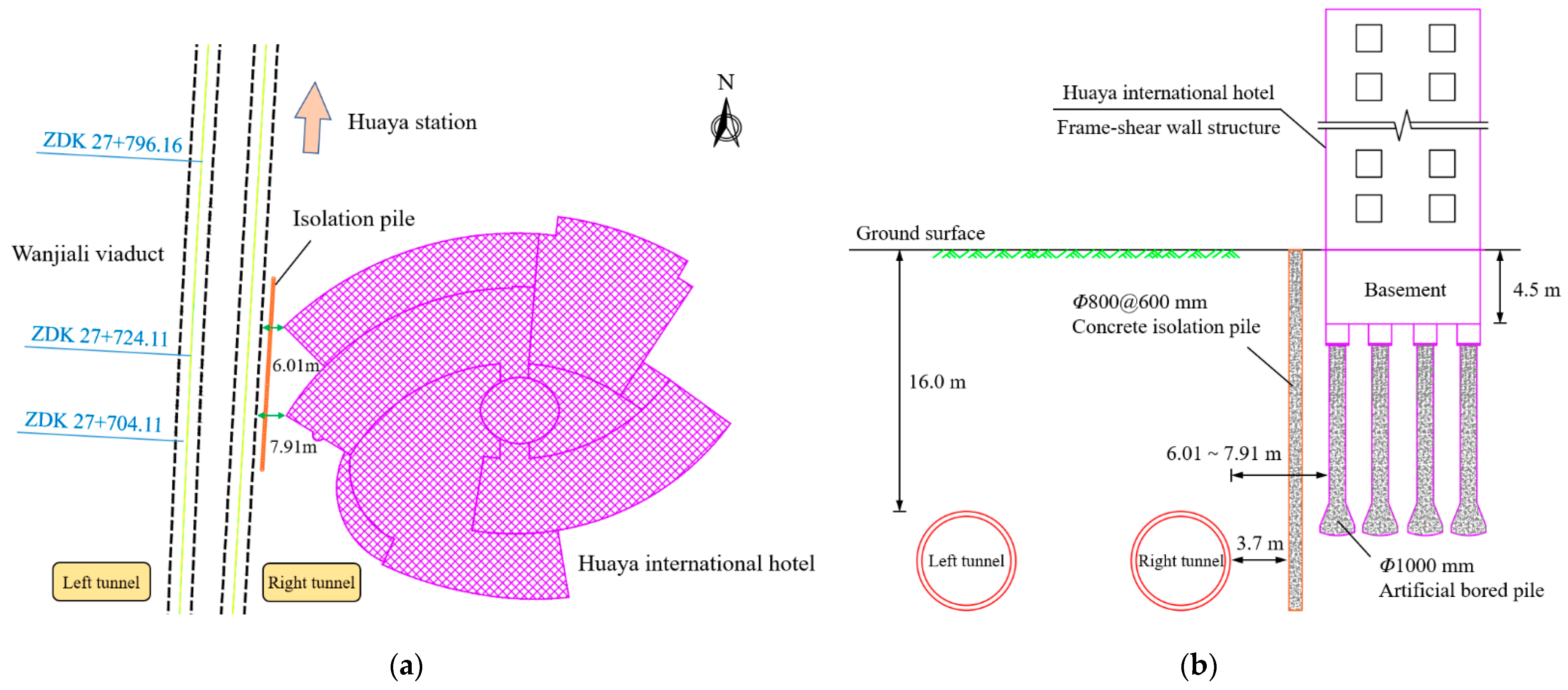

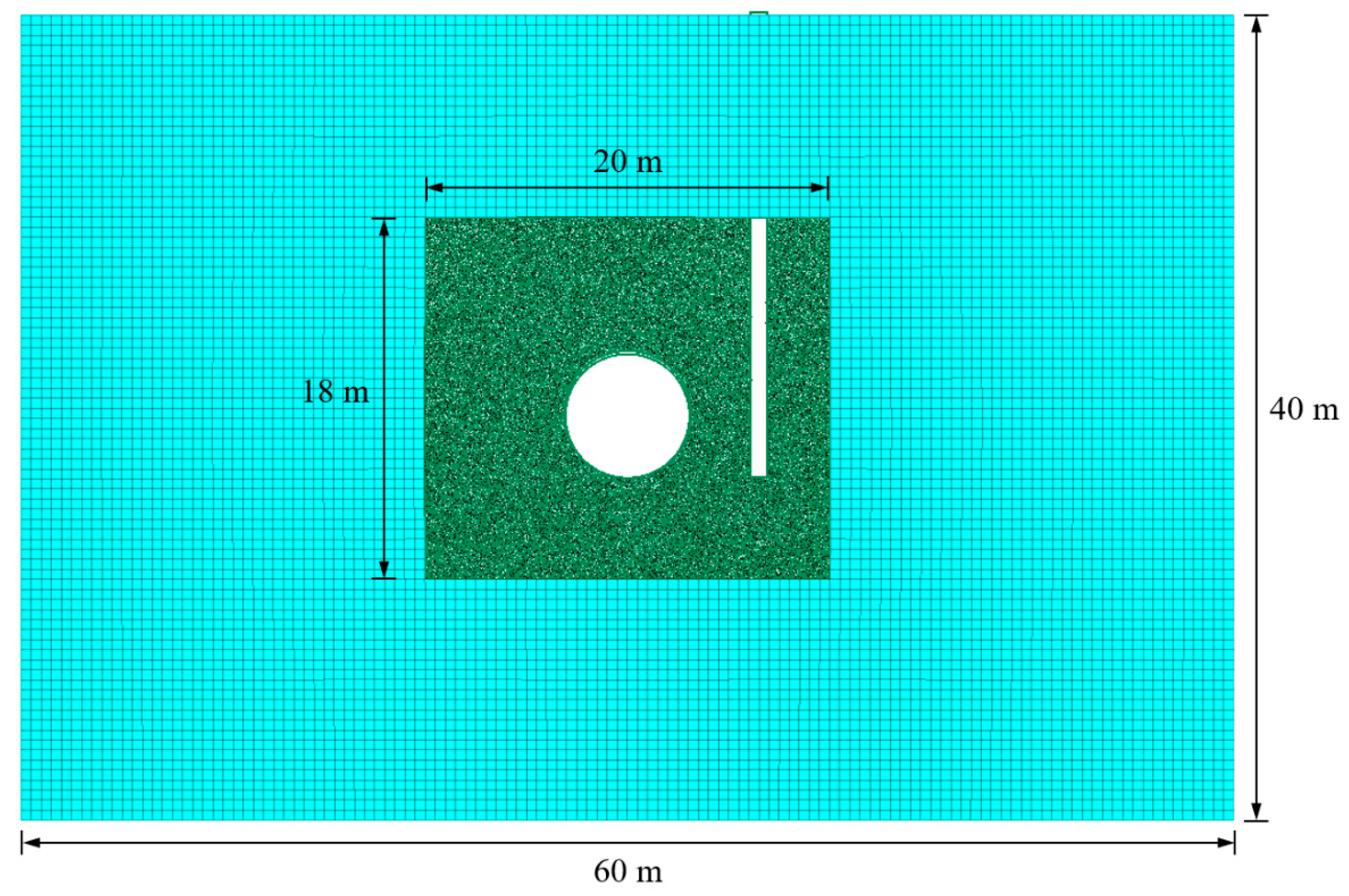
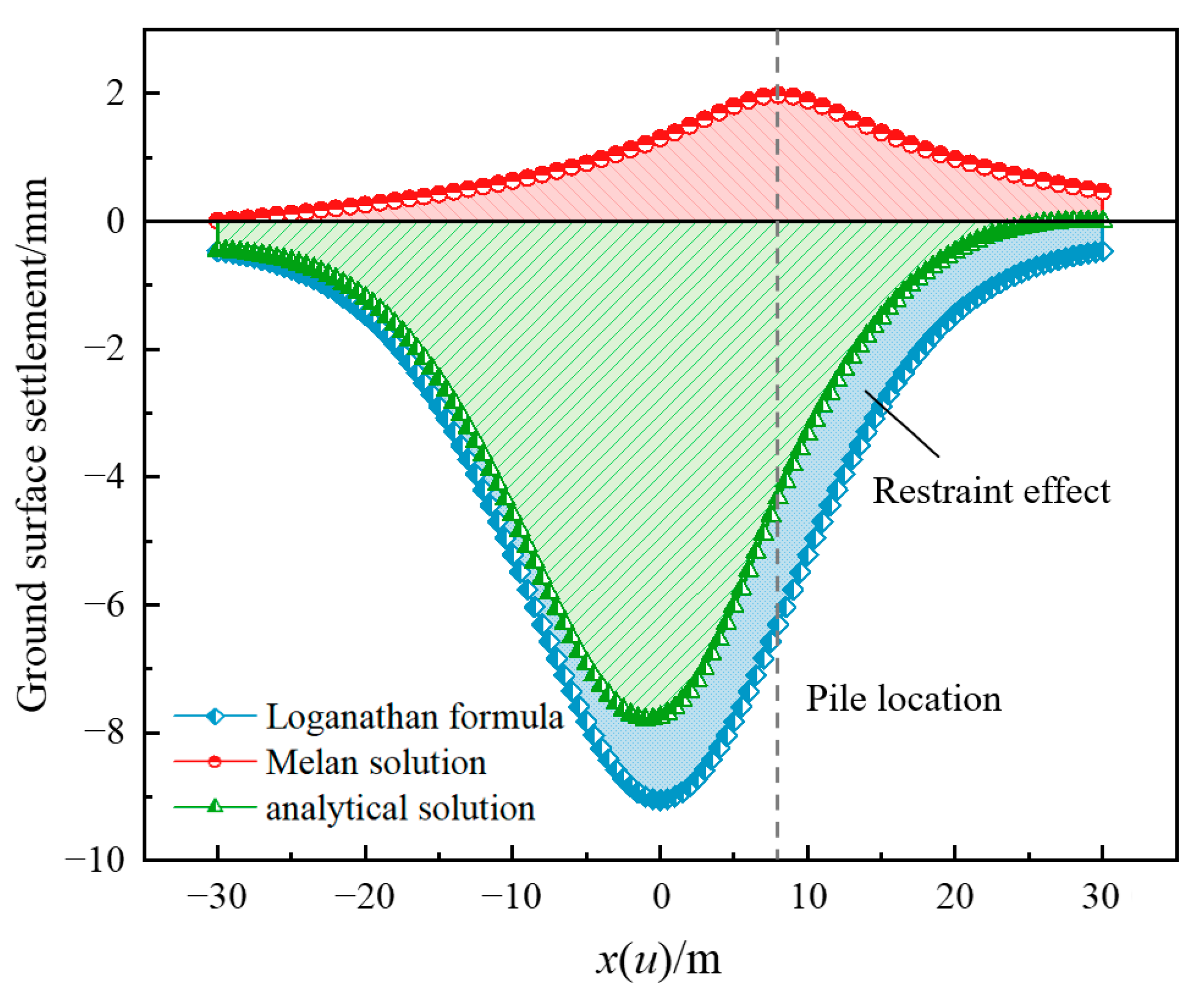

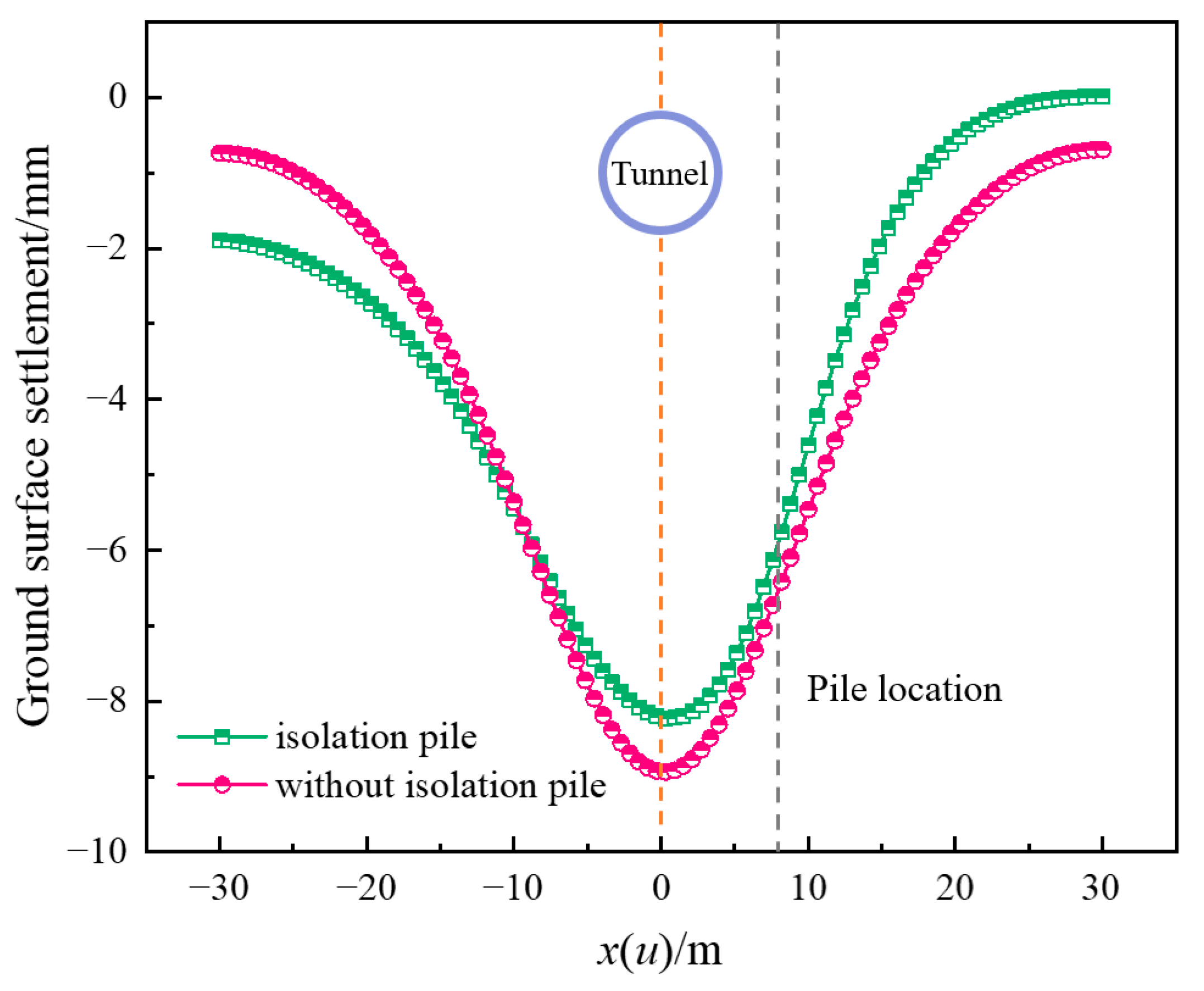
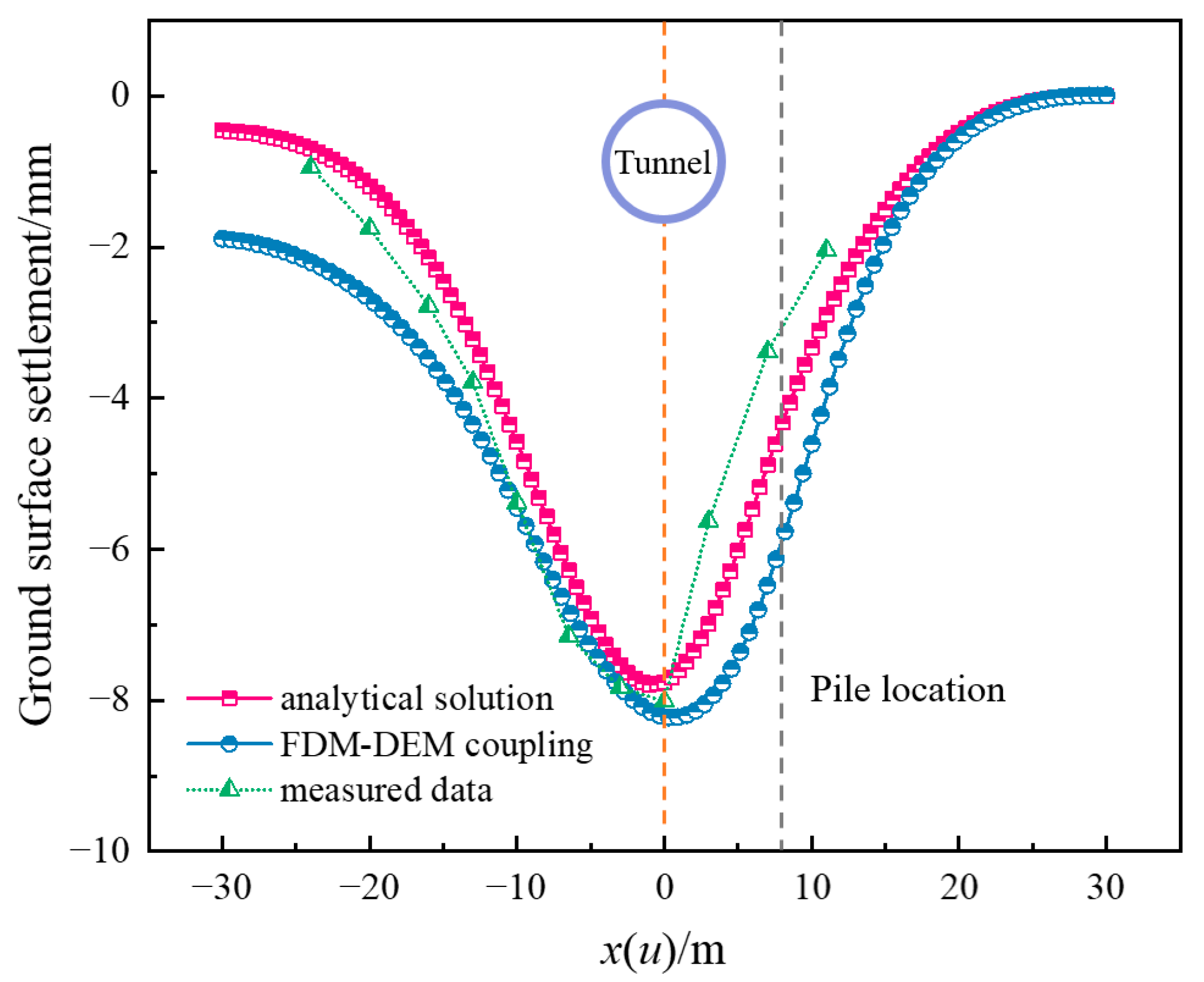
| Macroscopic Parameters | Young’s Modulus (MPa) | Density (kg/m3) | Poisson’s Ratio | Friction Angle (°) | Cohesion (kPa) |
|---|---|---|---|---|---|
| Soil mass | 75 | 2250 | 0.25 | 30 | 40 |
| Microscopic Parameters | Effective Modulus (MPa) | Normal Stiffness (N∙m−1) | Tangential Stiffness (N∙m−1) | Normal Bond (kPa) | Shear Bond (kPa) |
| Soil mass | 18.5 | 7.5 × 106 | 4.5 × 106 | 40 | 45 |
Publisher’s Note: MDPI stays neutral with regard to jurisdictional claims in published maps and institutional affiliations. |
© 2022 by the authors. Licensee MDPI, Basel, Switzerland. This article is an open access article distributed under the terms and conditions of the Creative Commons Attribution (CC BY) license (https://creativecommons.org/licenses/by/4.0/).
Share and Cite
Huang, K.; Sun, Y.; Kuang, X.; Huang, X.; Liu, R.; Wu, Q. Study on the Restraint Effect of Isolation Pile on Surface Settlement Trough Induced by Shield Tunnelling. Appl. Sci. 2022, 12, 4845. https://doi.org/10.3390/app12104845
Huang K, Sun Y, Kuang X, Huang X, Liu R, Wu Q. Study on the Restraint Effect of Isolation Pile on Surface Settlement Trough Induced by Shield Tunnelling. Applied Sciences. 2022; 12(10):4845. https://doi.org/10.3390/app12104845
Chicago/Turabian StyleHuang, Kan, Yiwei Sun, Xilong Kuang, Xianqiang Huang, Runing Liu, and Qijiang Wu. 2022. "Study on the Restraint Effect of Isolation Pile on Surface Settlement Trough Induced by Shield Tunnelling" Applied Sciences 12, no. 10: 4845. https://doi.org/10.3390/app12104845
APA StyleHuang, K., Sun, Y., Kuang, X., Huang, X., Liu, R., & Wu, Q. (2022). Study on the Restraint Effect of Isolation Pile on Surface Settlement Trough Induced by Shield Tunnelling. Applied Sciences, 12(10), 4845. https://doi.org/10.3390/app12104845






